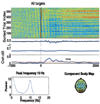Imaging Brain Dynamics Using Independent Component Analysis
- PMID: 20824156
- PMCID: PMC2932458
- DOI: 10.1109/5.939827
Imaging Brain Dynamics Using Independent Component Analysis
Abstract
The analysis of electroencephalographic (EEG) and magnetoencephalographic (MEG) recordings is important both for basic brain research and for medical diagnosis and treatment. Independent component analysis (ICA) is an effective method for removing artifacts and separating sources of the brain signals from these recordings. A similar approach is proving useful for analyzing functional magnetic resonance brain imaging (fMRI) data. In this paper, we outline the assumptions underlying ICA and demonstrate its application to a variety of electrical and hemodynamic recordings from the human brain.
Figures







References
-
- Herault J, Jutten C. Space or time adaptive signal processing by neural network models; presented at the Neural Networks for Computing: AIP Conf; 1986.
-
- Jutten C, Herault J. Blind separation of sources I. An adaptive algorithm based on neuromimetic architecture. Signal Process. 1991;vol. 24:1–10.
-
- Pham DT, Garat P, Jutten C. Separation of a mixture of independent sources through a maximum likelihood approach. presented at the Proc. EUSIPCO. 1992
-
- Comon P. Independent component analysis, a new concept? Signal Process. 1994;vol. 36:287–314.
-
- Cichocki A, Unbehauen R, Rummert E. Robust learning algorithm for blind separation of signals. Electron. Lett. 1994;vol. 30:1386–1387.
Grants and funding
LinkOut - more resources
Full Text Sources
Other Literature Sources
Miscellaneous
